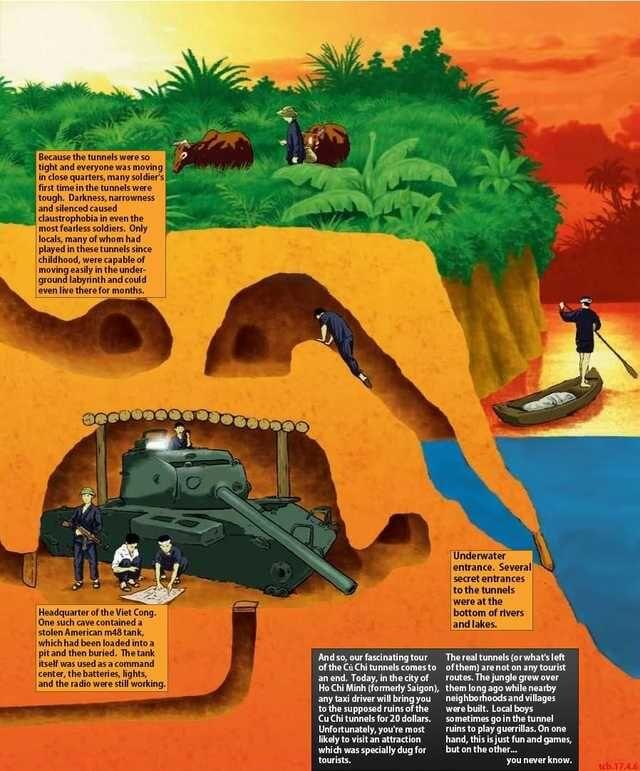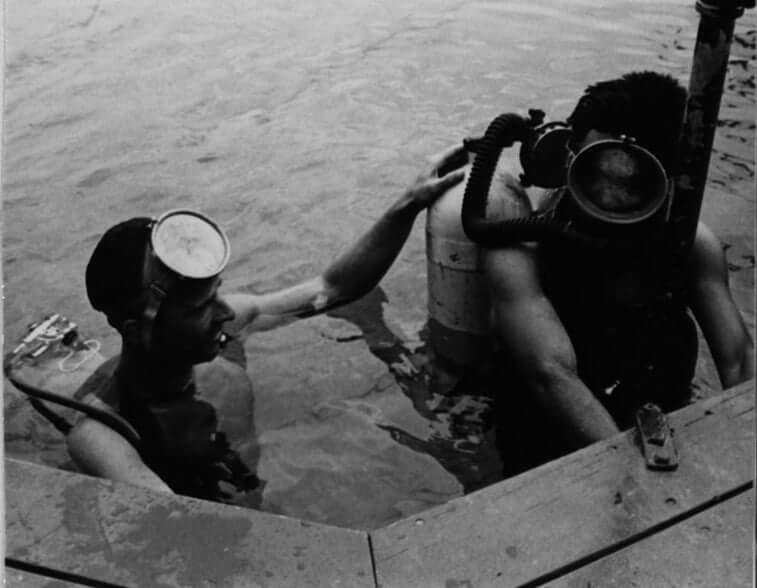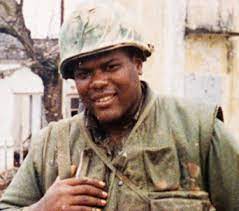When Vietnam was engulfed in war for the two decades between 1955 and 1975, the warfare techniques of the Vietnamese, the French, and the Americans varied massively. Both sides were forced to adapt to and utilize the terrain around them. One of the most overlooked aspects of the Vietnam War was the role that rivers played in the conflict. In this article, we’re going to dive into a gruesome tale of underwater combat that took place during the Vietnam War.

From the Mekong River to Perfume River, Vietnam is a country not short on waterways. In fact, the South Asian country is home to 2360 rivers with the total length at 41.900km. During the height of the Vietnam War, the Vietcong learned to utilize the waterways of the country in order to fight off their American adversary.
The guerrilla nature of warfare in Vietnam required the U.S. Navy to add various innovative watercraft to its arsenal and fight far inland on the country’s maze of rivers, something American sailors had not done in force since the Civil War. Whilst these boat crews were tasked with disrupting Viet Cong infiltration and resupply operations and destroying VC insurgents in their areas of operation and enforcing South Vietnamese government curfews, they often needed highly skilled men to get down and dirty to locate and destroy VC tunnels.

The entrances to said Vietcong tunnels were often located deep underwater, requiring skills divers to undertake the dangerous task of going under the river to seek and destroy. Naturally, this often resulted in some gruesome hand to hand combat with the VC defenders. There are many stories of subterranean close combat between Vietcong guerillas and U.S. soldiers, but few are as gruesome as that of Sgt. Robert Hughes.
Sgt. Robert Hughes

During the Vietnam War, Sgt. Robert Hughes was a Dive NCO for the First Recon Company of the U.S. Marines between 1967 and 1968. A large and powerful man who towered over many of his comrades, Robert Hughes was described as a “gentle giant” by the Marines who served with him. He was also known as claiming one of the most brutal kills of the Vietnam War.
The main duties of Sgt. Hughes was leading dive teams and maintaining the unit’s scuba diving equipment. However, when it came to donning his gear and submerging himself in the various treacherous waterways of Vietnam, the gentle giant personality of Sgt. Hughes disappeared as he prepared himself for the countless threats that often lurked beneath the water.
As well as the unforgiving natural threats in Vietnam, the rivers and waterway were often home to Vietcong divers or underwater entrances to Vietcong tunnels full of enemy fighters. It was not uncommon for U.S. troops hunting VC fighters to observe the Vietnamese flee underwater and never reemerge. Signaling that they had made their escape into one of the countless tunnel entrances located below the water.
Through the conflict in Vietnam, scuba trained Force Recon Marines carried out combat diving missions in a variety of roles. Inspecting bridges was a common role in case enemy sappers had booby-trapped them. Additionally, these diving teams would comb the river bed looking for bodies, equipment caches, or enemy tunnels. It was a mission of the latter variety where Hughes would earn his reputation.
“There was no one I would rather have as security underwater than Sgt Hughes”
– A Marine recollects his service with Sgt. Hughes.
As he donned his diving gear as he had done many times, Hughes was preparing himself for another mission underwater hunting VC tunnel entrances. Below the water, he cautiously made his way through the murky darkness straining his eyes for any threats around him. One hand was used to navigate his way along the riverbank, whilst his other hand firmly gripped a Kabar knife.
Hughes suddenly identified the entrance to a Vietcong tunnel but before he could react, a enemy VC diver burst out of it and grabbed onto Sgt. Hughes. The two adversaries were now locked onto each other in a fight to the death. Hughes quickly caught sight of a knife in the hand of the Vietcong diver and grabbed his wrist to prevent himself from being stabbed whilst simultaneously trying to plunge his Kabar into the enemy at the same time.
The VC diver copied Hughes, gripping his knife hand whilst trying to stab him with a Vietcong dagger. If the fight continued like this, both divers would likely drown unless one or the other got the upper hand. Hughes knew he had to improvise to win this fight and do it fast.
In lightning speed, Hughes pulled the Vietcong diver close to him by tightly wrapping his legs around his body. Now face to face, Hughes spat his diving regulator out of his mouth, pushed forward, and tore the enemy diver’s throat out with his teeth. As the mutilated diver released his grip, Hughes plunged his Kabar into him repeatedly for good measure. The fight was over and Hughes was soon back above the water.
This tale was one of at least two confirmed underwater kills this ”gentle giant” claimed throughout the conflict, and he was not the only one. Throughout the Vietnam War, there were multiple stories of grueling underwater battles fought between Marines and the Vietcong. Leading to the prevalence of a range of underwater weapons, although none as advanced as the technology of the Soviets who were designing the APS underwater rifle around the same era.
Whilst the iconic Kabar knife was the most valued weapon for underwater combat, many Marines brought privately bought revolvers with them. In underwater combat, a standard-issue Colt 1911 handgun was pretty much useless. A revolver, however, was said to still be operational. Thus, the riverbeds of Vietnam played host to numerous knife battles, shootouts, and other grueling examples of combat. But the story of Sgt. Hughes shedding his Gentle Giant aura is arguably the most infamous.
Sgt. Robert Larry “Bob” Hughes died on February 14th, 1990, in York, Pennsylvania. Bob is buried in the Indiantown Gap National Cemetery, Annville, Pennsylvania.
